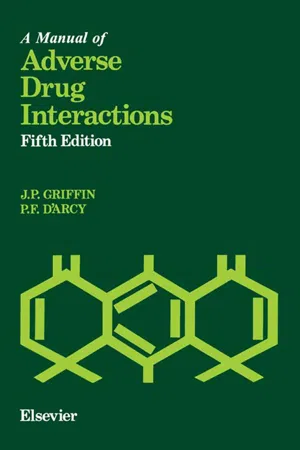
- 649 pages
- English
- ePUB (mobile friendly)
- Available on iOS & Android
A Manual of Adverse Drug Interactions
About this book
For twenty years this book, now in its 5th edition, has provided information on adverse drug interactions that is unrivalled in coverage and scholarship.Adverse drug reactions, many of them ascribable to interactions with other drugs or with chemical substances in food or the environment, are thought to cause or complicate one in twenty of hospital admissions.The book is conveniently divided into two parts: Part 1 comments on drug interactions and their mechanisms, on a pharmacokinetic and pharmacodynamic level, while Part 2 consists of drug interaction tables, divided and subdivided into categories of disorders, and the drugs used in the treatment of these disorders.If safety in drugs is to improve, education of prescribers is vitally important. This book, with its up-to-date and coordinated approach, serves that purpose well. The real threat, as the authors remind us, is the ignorance of practitioners, not the drug itself. The volume is therefore an essential addition to the shelves of those responsible for the prescription of drugs, in order to prevent a potential backlash when used in combination with other drugs or chemical substances.
Frequently asked questions
- Essential is ideal for learners and professionals who enjoy exploring a wide range of subjects. Access the Essential Library with 800,000+ trusted titles and best-sellers across business, personal growth, and the humanities. Includes unlimited reading time and Standard Read Aloud voice.
- Complete: Perfect for advanced learners and researchers needing full, unrestricted access. Unlock 1.4M+ books across hundreds of subjects, including academic and specialized titles. The Complete Plan also includes advanced features like Premium Read Aloud and Research Assistant.
Please note we cannot support devices running on iOS 13 and Android 7 or earlier. Learn more about using the app.
Information
INTRODUCTION: A WIDENING PROBLEM
Table of contents
- Cover image
- Title page
- Table of Contents
- Copyright
- FOREWORD
- PREFACE TO FIFTH EDITION
- PREFACE TO FOURTH EDITION
- PREFACE TO THIRD EDITION
- PREFACE TO FIRST EDITION
- ACKNOWLEDGEMENTS
- Part 1: Commentary on Drug Interactions and their Mechanisms
- Part 2: Drug Interaction Tables
- ANNEX 1
- Index